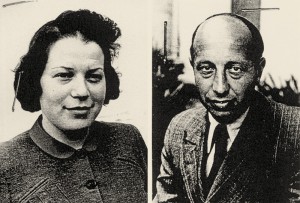
On 20 May 1942 Sally and Hanna Goldschmidt received the order to proceed to the Wholesale Market for departure. They had just gotten married in December 1941 and had been living at Röderbergweg 38 for six months when the deportation order threatened their lives. Both decided to go into hiding. Sally had already approached his non-Jewish friend Josef Balthasar, who had hidden several men in his tailor shop at Kronprinzenstrasse 19 (today: Münchener Strasse) in November 1938. They went into hiding at Balthasar’s shop together with their friend Bruno. The three lived in a small room under the roof for thirteen weeks. They could not stay there forever and after staying an additional week by another woman, whose name was Mrs. Prösser, they made their first attempt to cross over into Switzerland. While in Frankfurt they had obtained the name of a man, who guided people across the border in exchange for money. They traveled to Bregenz via Heidelberg, Friedrichshafen and Lindau. As they did not have any papers they decided to travel via milk trains, which were less controlled. They waited in the forest close to the border for a favorable time to cross, but their attempt to escape was blocked by numerous flares and controls. They traveled from Bregenz via Ulm, back to Frankfurt and went into hiding again at their friend Balthasar’s shop. Their friend Bruno had been arrested at the Ulm railway station when he was stopped by the Gestapo who was checking his documents. As the Gestapo was occupied with Bruno’s paperwork Sally and Hanna managed to escape to the railway station toilets without being noticed until it was safe for them to come out again. They were taken care of by Josef Balthasar and good friends upon their return to Frankfurt and were able find a night’s refuge with many different room landlords. They presented themselves most often as air raid victims who had lost their apartment and needed a place to stay. Hanna was recognized at least twice in their neighborhood Rödelheim while looking for food and by a railway controller at the railway station. They were no longer safe in Frankfurt.
Their next attempt to escape to Switzerland would take them via Straßburg. Sally remembered a friend and hoped to find him in Straßburg. They reached their goal by again traveling on milk trains and hoped to have luck finding a privately rented room. They found a room in the “Rue Kuhn”, not far from the Straßburg Railway Station by a family whose name was Fiegenwald. As their hosts did not make any secret of their anti-Nazi feelings they told them the true reason for their trip — escape to Switzerland. The Fiegenwalds promised to inquire about their friend, whom they were actually able to find. A lot of time went by until their friend made contact with the resistance movement, who had smuggled the French General Giraud across the border six months earlier after he had escaped from imprisonment in a fortress. They were told that if they managed to get to Mulhouse a man would contact them there. In Mulhouse it was suggested to them to jump on a train. Sally immediately said: Yes! They waited two weeks in the “Hotel du Parc” for the right moment. They went to the railway station St. Louis very early and jumped on a freight train. However, only Sally managed the high jump onto the Swiss platform on 21 January 1943 at 6:00 a.m. Hanna was unsuccessful at her first attempt to jump and remained behind. Ten days later, on 2 February at 4:00 a.m. she too reached safe Swiss territory with the help of the same young man. At the first opportunity after the war in 1946 Hanna and Sally Goldschmidt along with their one-year-old son, emigrated to relatives in the USA..
See: Interview with Hannah Goldsmith by the Shoah Foundation in the US Holocaust Memorial Museum, Washington DC, Collection 38581; Petra Bonavita: Mit falschem Pass und Zyankali, Stuttgart 2009, pages 58-59.